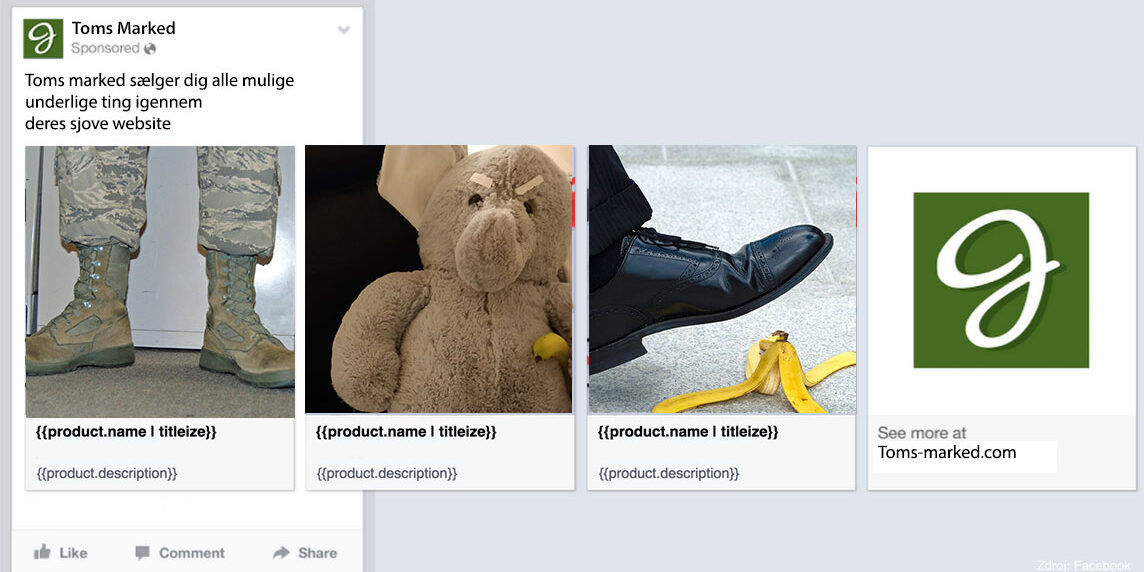Everyone is on Facebook – that’s how it feels, at least. In Denmark, there’s some truth to it, as the majority of adult Danes have a profile on the social network, opening up access to an audience that’s hard to find elsewhere.
Having so many people gathered on one platform naturally makes it an ideal place to advertise products or services.
Regardless of what you sell or offer, there’s likely someone on Facebook who finds it interesting, even if it’s related to the workplace. Therefore, selling B2B on Facebook is entirely feasible, but that’s another story.
Another reason to use Facebook and its advertising tools is that they are quite clever. There are many ways to customize, adjust, fine-tune, and optimize, which is smart for keeping costs down.
It’s also smart for keeping revenue up, and one way to achieve both is by leveraging the opportunity of dynamic ads.
The Foundation of Dynamic Ads Lies In the Product Catalog.
Before we delve into what dynamic ads are, I’d like to draw your attention to the foundation of it all.
Without a product catalog, dynamic ads cannot be created. Read more about avecdo’s Facebook product catalog here.
The product catalog is where Facebook extracts data when the technology behind it compiles ads for individual recipients.
Setting it up visually is rather dull, unless you have smart software like avecdo to handle everything for you. It typically involves a large CSV or XML file, often created in good old Excel.
Then it’s a matter of filling in information about the product’s ID, name, stock status, color variations, and so on.
It’s crucial to have all the relevant information and set it up correctly. It goes without saying, but without the right information, Facebook cannot create dynamic ads, possibly with dynamic images.
The brilliance of dynamic ads is that Facebook generates them automatically. If you have to manually add information to make the ads work, the smart aspect disappears.
Oh Yes – and, Of Course, the Facebook Pixel.
There is another piece of the puzzle that needs to be in place before we dive into the actual ads, and I’ll keep it relatively brief. You need to have your Facebook Pixel sorted.
If you’re not familiar with the Pixel, it’s a small cookie that allows tracking of visitors and keeps tabs on what they’re browsing on your site.
If you’ve already implemented the Pixel, make sure you’ve set it up correctly for dynamic ads. You’ll need to register events on your site to target the right audience. At a minimum, you should register events for purchases, adding to cart, and viewing content. But the more you know about your visitors, the better.
Dynamic Ads Save You Time.
 Here it is! Facebook’s dynamic ads! It’s simply ingenious, and it’s automated. With the right setup, Facebook’s software can do a lot of the work on its own.
Here it is! Facebook’s dynamic ads! It’s simply ingenious, and it’s automated. With the right setup, Facebook’s software can do a lot of the work on its own.
It requires some initial preparation, but for the most part, it’s something you only need to do once, and then it pretty much runs itself. Therefore, setting up dynamic ads can save a lot of work time, ensuring they reach the relevant audience.
Facebook’s product feed
The ads are structured in a way that observes what a person has looked at (technically, it’s the device and not the person, but that’s just a technical detail), and the ads think it’s probably relevant to the visitor. Then, the ad content is pieced together based on that information.
The fact that so much happens automatically makes them very effective in terms of workload, because once it’s set up, it can manage itself. Instead of creating new ads from scratch every time, it only needs to be done once.
The next time you need to create a new ad, you can focus on something else because the system figures out what it needs on its own, more or less. In a nutshell.
The Customer is Interested in the Product.
From the customer’s perspective, it’s also a positive experience to see ads related to things they are interested in. Many people feel this way, at least.
Instead of having to look at ads for summer dresses when someone exclusively wears jeans, they actually get served advertising that is relevant to them. It’s not just noise, and that’s appreciated by many.
There are also instances where a potential customer has simply moved away from a purchase, even though they initially wanted what you offer. In such cases, it’s nice to be reminded of what was forgotten so that they can acquire what they visited a site for.
It's Personalized Advertising, When Done Correctly.
When everything is set up in the best possible way, you can actually create highly personalized ads. And if you manage to do that, you can truly boost your effectiveness on the world’s largest social media platform.
People love it when something is made just for them. It makes them feel special, like someone has invested time in them.
You’ve probably experienced this yourself – when someone does something for you, it brings a sense of joy.
Even if you don’t necessarily feel ecstatic about being targeted by an ad, there’s a similar psychological mechanism at play. Receiving something tailored specifically to you creates a greater inclination to click and learn more.
Hence, envisioning a wording and a technical setup that truly enhances the feeling of uniqueness for the recipient is easy.
“For instance, ‘Hey, we noticed you recently checked out red rain boots. If red isn’t your color, explore all our variations here,’ could be a compelling message.
This way, you convey that this ad is exclusively for them, showcasing a high level of customer service to the potential customer.
Have You Been Listening?
Let’s recap because that’s how human brains work – we like to summarize when we’ve been attentive for a while. So:
- Dynamic ads are clever because they can be automated, saving you work time.
- To create dynamic ads, you need a product catalog. Note: You can obtain one through avecdo.
- A correctly configured Facebook Pixel is also necessary for dynamic ads.
- Dynamic ads allow you to provide a highly individualized experience for the recipient, which is beneficial.
- Using dynamic ads on Facebook is a great idea for many advertisers on the platform.
In another way, you could say – if you manage to set up things correctly, it becomes easier for you to sell through Facebook.
 Mikkel Guldbjerg Jensen
Mikkel Guldbjerg Jensen
Online Marketing Consultant
As a valuable member of the OnlineSynlighed.dk team, Mikkel possesses extensive experience and a wide network across various marketing channels. His background as a journalist makes him an excellent communicator across platforms – a skill that benefits the agency’s clients.




